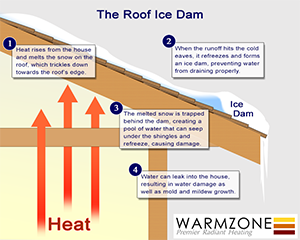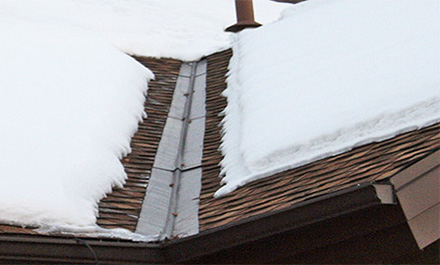Sun Valley Roof Deicing and Gutter Heat Trace Systems
The single most common – and costly – roof problem caused by snow and ice is that of the ice dam. While a roof deicing system can help to prevent ice dams from forming, it’s important for homeowners to also be aware that the major cause of ice dams is a poorly insulated attic. In other words, the first step in caring for your roof is to ensure that your attic is ventilated and well insulated.
 Poorly insulated attics allow heat to escape and warm the roof above. As this happens,
the bottom layer of snow melts. The runoff trickles down to the eaves, but because no warmth
from the attic reaches the eaves, the roof edges are significantly colder, and oftentimes the
runoff refreezes at it approaches the roof’s edge. This frozen water creates a small ridge,
and over time additional runoff can repeat this process and the ice ridge increases in size.
Eventually, water pools behind the ridge of ice, and this is where the problems can start.
Poorly insulated attics allow heat to escape and warm the roof above. As this happens,
the bottom layer of snow melts. The runoff trickles down to the eaves, but because no warmth
from the attic reaches the eaves, the roof edges are significantly colder, and oftentimes the
runoff refreezes at it approaches the roof’s edge. This frozen water creates a small ridge,
and over time additional runoff can repeat this process and the ice ridge increases in size.
Eventually, water pools behind the ridge of ice, and this is where the problems can start.
Standing pools of water on a roof allows water to seep into every nook and cranny. As that water refreezes at night, it expands and accentuates every tiny crack or flaw in the roof. Eventually water may even find a way to seep inside the home. This can lead to water and mold damage; two things a homeowner never wants to hear about or deal with.
Low-voltage Roof Deicing
Warmzone’s low-voltage RoofHeat STEP deicing system may be the industry’s best solution for preventing ice dams by keeping roof edges clear of snow and ice. This self-regulating system features thin, 12-inch wide polymer heating panels that are installed discreetly under the roof shingles. (The heating element can also be safely installed under metal roofs.) The flexible element can be nailed and stapled through, facilitating the installation process.
Installing this system along the roof edges and in valleys is an ideal way to protect your roof by ensuring runoff and preventing ice dams. With the exception of the melted snow in the winter, you can’t even tell that you have a deicing system installed on your roof.
 Self-Regulating Heat Trace
Self-Regulating Heat Trace
 Another option to combat ice dams, as well as to keep gutters and downspouts ice free, is
to install self-regulating heat trace cable. This is perhaps the most affordable roof deicing
option. The cable is typically zigzagged along the roof edges to provide channels for the runoff,
effectively dismantling the threat posed by ice dams. To protect gutters in Sun Valley from heavy
ice damage and facilitate runoff, the heat cable is routed directly through the gutters and
downspounts.
Another option to combat ice dams, as well as to keep gutters and downspouts ice free, is
to install self-regulating heat trace cable. This is perhaps the most affordable roof deicing
option. The cable is typically zigzagged along the roof edges to provide channels for the runoff,
effectively dismantling the threat posed by ice dams. To protect gutters in Sun Valley from heavy
ice damage and facilitate runoff, the heat cable is routed directly through the gutters and
downspounts.
Call Warmzone today to learn more about your roof heating options. In addition to a wide selection of custom options, Warmzone also includes free installation training and support. We’ll assist you if you have any questions during the installation. Call 888.488.9276 today.
